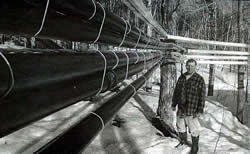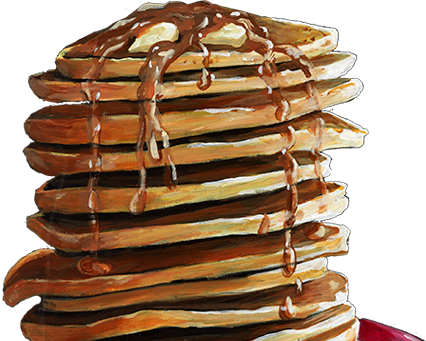The Stowe Reporter
Thursday, March 20, 2003
By Ethan Dezotelle Joe Russo was a very happy man last Sunday. As temperatures broke into high 50’s around the state on March 16 and put an end to an unseasonably cold winter, maple syrup producers sprang into action as sap dripped into buckets and flowed down pipelines.
Joe Russo was a very happy man last Sunday. As temperatures broke into high 50’s around the state on March 16 and put an end to an unseasonably cold winter, maple syrup producers sprang into action as sap dripped into buckets and flowed down pipelines.
For Russo, who operates in Belvidere the largest sugar bush in the state, according to the Vermont Department of Agriculture, it’s a day that’s been a long time coming.
“It’s a hell of a run and a great day,” Russo said Sunday afternoon as he stood next to a series of large pipelines running from the heights of the mountain behind his sugarhouse to two gathering tanks at its base. “I want to keep up with the flow. I don’t like the sap to sit around too long.”
Sitting is something neither Russo, his two employees, nor the sap get much time to do. With a maple producing process of his own design, Russo aims to make syrup in the most efficient way possible.
His 32,000 taps – plus another 5,000 up in Coventry – are only the beginning of what is one of the most cutting-edge sugaring operations in Vermont. Seven vacuum boosted pipes run for several miles through Russo’s property at the end of Boarding House Road.
Once the sap leaves the pipes, it’s a relatively quick trip to becoming maple syrup.
“We make the best possible product here by using steam,” Russo said. “It’s a system of my own design. You can’t buy what we work with here.”
 The process starts with the sap being filtered as it leaves the holding tanks, a fairly common sense practice. Reverse osmosis, a modern sugaring process that uses a high pressure pump to force water out of the maple sap through a membrane, brings Russo’s sap up to a 15 percent concentration of sugar. The concentrated liquid is then pumped into two 2,00-gallon tanks.
The process starts with the sap being filtered as it leaves the holding tanks, a fairly common sense practice. Reverse osmosis, a modern sugaring process that uses a high pressure pump to force water out of the maple sap through a membrane, brings Russo’s sap up to a 15 percent concentration of sugar. The concentrated liquid is then pumped into two 2,00-gallon tanks.
This is where Russo’s sugaring system really deviates from the norm.
The sap is run through two pre-heaters that bring the liquid up to a temperature of just above boiling. Then the sap hits the pan to be boiled down to syrup. The pan is lined with copper coils that are super-heated with steam.
“It gets so hot in the pan that it scares us,” Russo said of the boiling temperature of the sap. “When the sap hits the pan it sounds like there’s a tiger in there. It’s just an incredible roar.”
After the sap is boiled into syrup, it gets drawn out of the pan automatically and is pumped into 55-gallon barrels.
The whole process produces seven barrels of maple syrup an hour, and Russo has tweaked his system enough so it takes less than half a gallon of fuel oil (to run the boilers) to produce one gallon of maple syrup.
The conventional method of evaporating sap to make maple syrup by using a wood fire can take several hours to produce just one barrel of syrup.
As Russo himself admitted, “Steam alone will not get you quality. It’s taken many years to perfect.”
To some degree, Russo, who spends eight months each year as a director of hotel services for Holland America cruise lines, has been working on this system his whole life.
As a teenager in upstate New York, Russo’s passion for sugaring led the state board of education to give him time off from school every spring to operate a sugar house on his own. In 1985, he purchased a small sugarplace in Coventry, which one of his employees still operates as a traditional wood fired operation. Then seven years ago he made his way to Belvidere, where he has spend every winter since. He even lives in his sugar house much of the season, cooking pancakes on the little wood stove and sleeping in the recliner his father passed away in.
This year he has nearly tripled the number of taps he works with, which he estimates will bring in around 300 barrels of syrup. Last year Russo tapped a relatively paltry 13,700 trees. Yet even that number is well above the statewide average of between 2,000 and 5,000 taps. The department of agriculture said perhaps two other maple producers in the state work in the same realm as Russo. One of Stowe’s largest producers, Paul Percy, handles around 24,000 taps.
But size isn’t everything for Russo.
“I don’t really think about it,” he said. “An operation like this has to be handled properly or it just doesn’t work. I wouldn’t do this on a large scale if I was uncertain about it.”
The confidence Russo has in his operation means even more work next year and each year to come as he hopes to expand into the rest of his Belvidere property.
One hundred thousand taps is the ultimate goal the maple producer has set for himself, and it’s a goal he believes is well within his reach.
This weekend Russo opens his sugarhouse to the public as part of Vermont’s Maple Open House weekend. He plans to not only share his sugaring operation, but also his homemade donuts and pancakes, an outlet for his love of the culinary arts.
“Of course, if the weather works out and the saps running in like we hope, I won’t be talking much to the people that visit,” Russo said. “That’s jus the nature of the work though, and I think people will be happy with what they see, regardless of whether I get to open my mouth.”



